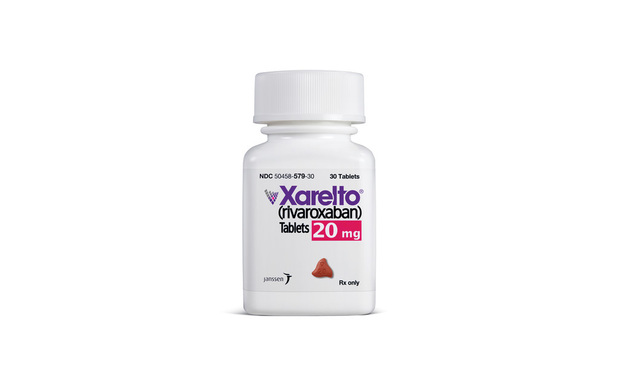Xarelto Openings Focus on Label, Dangers
The label for the blood thinner Xarelto was front and center during opening statements Monday in the first trial over the stroke-prevention medication.
November 06, 2017 at 06:28 PM
3 minute read

The label for the blood thinner Xarelto was front and center during opening statements Monday in the first trial over the stroke-prevention medication.
Attorneys for the plaintiffs contended drugmakers Janssen Pharmaceutical and Bayer downplayed key warnings to boost sales and manipulated the approval process to make the drug seem more effective and safer than other medications.
“In a word, this is the bible for the drug,” Douglas & London attorney Gary Douglas told the 14 jurors as he held the lengthy, single sheet of the label covered in fine print. He added that, although the label was approved by the U.S. Food and Drug Administration, “We will show you that FDA approval of Xarelto is not what it's cracked up to be. Like many government agencies, they're not perfect. What a shock.”
Beth Wilkinson of Wilkinson Walsh & Eskovitz also showed the jurors the label, but she said everything the defendants are accused of leaving out is included.
“Anything about stacking the deck, that's just false,” Wilkinson said. “None of that was secret.”
Opening statements in Hartman v. Janssen began Monday afternoon in Philadelphia Court of Common Pleas Judge Michael Erdos' courtroom. The start of trial was delayed after plaintiffs counsel Monday morning raised concerns about an allegedly previously undisclosed contact between a Janssen sales rep and a treating doctor for the plaintiff, Lynn Hartman.
Hartman is the first bellwether trial to begin in states court. Over the summer, defendants won all three cases that went to trial from the consolidated litigation being handled in federal court. More than 18,000 cases are pending in the federal multidistrict litigation over Xarelto, which makes it the second largest litigation nationwide, second only to the consolidated pelvic mesh litigation. More than 1,500 Xarelto cases are pending in Philadelphia.
During the roughly 75-minute opening on behalf of the plaintiffs, Douglas focused on what he called the “grossly inadequate” label, and said it failed to take into account the magnitude of the risks involved.
Levin Papantonio Thomas Mitchell Rafferty Proctor attorney Ned McWilliams accompanied Douglas in making the opening statement, and went over the study the defendants conducted comparing Xarelto to Warfarin, which was an earlier class of blood-thinner. According to McWilliams, the defendants “stacked the deck” with doctors who were not well equipped to handle Warfarin, which helped make Xarelto seem more effective.
“This was an intentional act, and they knew what they were doing,” McWilliams said. ”Don't stack the deck when peoples' lives are literally in the balance.”
Wilkinson, however, said details about those studies, including how well the patients taking Warfarin were managed, were included on the label. Both Hartman and her treating physician knew of the risks, and the treating doctor further testified that even with the additional information about the magnitude of the risk, she still would have prescribed the drug to Hartman, Wilkinson told the jury.
Wilkinson also showed jurors a detailed animation of how atrial fibrillation, a heart condition that Hartman suffered from, can lead to blood clots and stroke, which can cause severe brain damage.
“She understands those risks and she thinks the benefits outweigh those risks,” Wilkinson said.
This content has been archived. It is available through our partners, LexisNexis® and Bloomberg Law.
To view this content, please continue to their sites.
Not a Lexis Subscriber?
Subscribe Now
Not a Bloomberg Law Subscriber?
Subscribe Now
NOT FOR REPRINT
© 2025 ALM Global, LLC, All Rights Reserved. Request academic re-use from www.copyright.com. All other uses, submit a request to [email protected]. For more information visit Asset & Logo Licensing.
You Might Like
View All
Lawsuit Against Major Food Brands Could Be Sign of Emerging Litigation Over Processed Foods
3 minute read

People in the News—Jan. 23, 2025—Marshall Dennehey, Duane Morris, Hangley Aronchick
3 minute read
Plaintiff Argues Jury's $22M Punitive Damages Finding Undermines J&J's Talc Trial Win
4 minute readTrending Stories
Who Got The Work
J. Brugh Lower of Gibbons has entered an appearance for industrial equipment supplier Devco Corporation in a pending trademark infringement lawsuit. The suit, accusing the defendant of selling knock-off Graco products, was filed Dec. 18 in New Jersey District Court by Rivkin Radler on behalf of Graco Inc. and Graco Minnesota. The case, assigned to U.S. District Judge Zahid N. Quraishi, is 3:24-cv-11294, Graco Inc. et al v. Devco Corporation.
Who Got The Work
Rebecca Maller-Stein and Kent A. Yalowitz of Arnold & Porter Kaye Scholer have entered their appearances for Hanaco Venture Capital and its executives, Lior Prosor and David Frankel, in a pending securities lawsuit. The action, filed on Dec. 24 in New York Southern District Court by Zell, Aron & Co. on behalf of Goldeneye Advisors, accuses the defendants of negligently and fraudulently managing the plaintiff's $1 million investment. The case, assigned to U.S. District Judge Vernon S. Broderick, is 1:24-cv-09918, Goldeneye Advisors, LLC v. Hanaco Venture Capital, Ltd. et al.
Who Got The Work
Attorneys from A&O Shearman has stepped in as defense counsel for Toronto-Dominion Bank and other defendants in a pending securities class action. The suit, filed Dec. 11 in New York Southern District Court by Bleichmar Fonti & Auld, accuses the defendants of concealing the bank's 'pervasive' deficiencies in regards to its compliance with the Bank Secrecy Act and the quality of its anti-money laundering controls. The case, assigned to U.S. District Judge Arun Subramanian, is 1:24-cv-09445, Gonzalez v. The Toronto-Dominion Bank et al.
Who Got The Work
Crown Castle International, a Pennsylvania company providing shared communications infrastructure, has turned to Luke D. Wolf of Gordon Rees Scully Mansukhani to fend off a pending breach-of-contract lawsuit. The court action, filed Nov. 25 in Michigan Eastern District Court by Hooper Hathaway PC on behalf of The Town Residences LLC, accuses Crown Castle of failing to transfer approximately $30,000 in utility payments from T-Mobile in breach of a roof-top lease and assignment agreement. The case, assigned to U.S. District Judge Susan K. Declercq, is 2:24-cv-13131, The Town Residences LLC v. T-Mobile US, Inc. et al.
Who Got The Work
Wilfred P. Coronato and Daniel M. Schwartz of McCarter & English have stepped in as defense counsel to Electrolux Home Products Inc. in a pending product liability lawsuit. The court action, filed Nov. 26 in New York Eastern District Court by Poulos Lopiccolo PC and Nagel Rice LLP on behalf of David Stern, alleges that the defendant's refrigerators’ drawers and shelving repeatedly break and fall apart within months after purchase. The case, assigned to U.S. District Judge Joan M. Azrack, is 2:24-cv-08204, Stern v. Electrolux Home Products, Inc.
Featured Firms
Law Offices of Gary Martin Hays & Associates, P.C.
(470) 294-1674
Law Offices of Mark E. Salomone
(857) 444-6468
Smith & Hassler
(713) 739-1250





